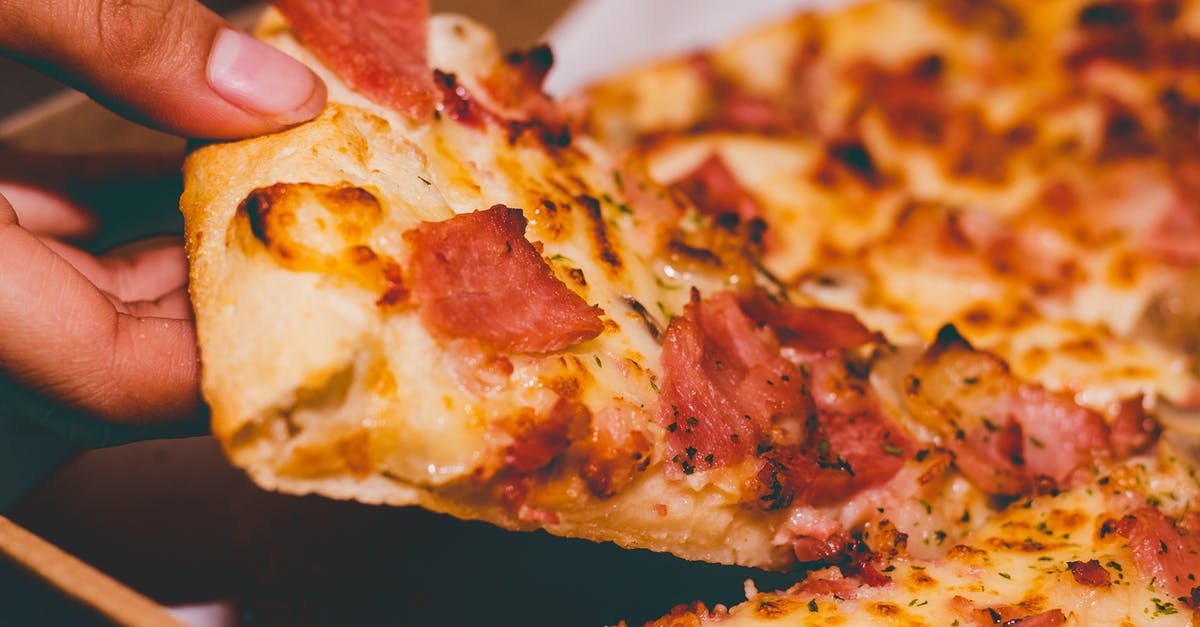What is "pizza crust yeast"?

Someone gave me a bunch of envelopes of pizza crust yeast, "specially formulated for pizza crust". The packets also say that no rise time or proofing is needed, and that it's "NOT recommended for bread baking." The ingredients are yeast, enzymes, sorbitan monostearate, l-cysteine, and ascorbic acid. It does provide a recipe for pizza crust, with just mixing and a bit of kneading.
What has actually been done to this yeast to make it work like this? (What are those enzymes?) And is there any way I can use it for other things, or is it really only good for things like pizza crust?
Best Answer
It sounds like you have Fleischman's Pizza Crust Yeast (or a no-doubt quite similar product if from another manufacturer). The relevant phrase from the Fleischman marketing web site is:
Pizza Crust Yeast is specially-formulated with dough relaxers that keep the dough from pulling or snapping back when shaping it.
It is intended to make it easier to stretch the pizza dough into shape.
The yeast itself is normal instant yeast, to the best of my knowledge—the additives in the packet are what make it "pizza crust yeast".
Researching the additional ingredients other than yeast:
Sorbitan monostearate—According to Sci Toys is an emulsifier with a polar and non-polar ends:
Sorbitan monostearate is used as an emulsifying agent in cake mixes, icings, baked goods, puddings, imitation whipped cream, hemorrhoid creams, and creams to treat dry skin.
Cooking for Engineers mentions that this helps the dough absorb the water.
l-cysteine*—is an amino acid, which is naturally occurring, and often extracted from hair or feathers. This article from LALLEMAND explains the science in bread dough, where it acts as a reducing agent:
During mixing the gluten in the ?our is stretched and pulled apart so that it can be reformed during proo?ng and baking to provide the needed strength and structure. Reducing agents act like mixing to reversibly break down gluten so that once they have been used up the gluten reforms. This mechanism is the opposite of oxidizing agents, which build up gluten. Reducing and oxidizing agent
ascorbic acid*—is of course Vitamin C, and a fairly strong acid. According to Effect of Ascorbic Acid on the Rheological Properties of Wheat Fermented Dough in Czeck Journal of Food Sciences, at concentrations under 0.6% it has little effect on wheat flour, so it is unlikely to have any practical effect in a full batch of pizza dough. Its inclusion is probably (as mentioned in Cooking for Engineers) as an anti-oxidant and preservative in the packet, rather than as an active ingredient in the bread dough.
enzymes—no doubt the particular enzymes and their ratios are proprietary to the brand you have, but according to the Wikipedia article on flour treatment agents, they are used to increase transformation of starch into sugars to facilitate the action of the live yeast. Common enzymes used include:
- Amylases break down the starch in flours into simple sugars, thereby letting yeast ferment quickly.
- Malt is a natural source of amylase.
- Proteases improve extensibility of the dough by degrading some of the gluten.
- Lipoxygenases oxidize the flour.
See also this Baker's Yeast article from Cooking for Engineers which discusses various commercially available forms of yeast.
My personal opinion is that I would not buy "pizza crust yeast," since recipes are not designed for the presence of its dough conditioners. I would rather control my dough's ingredients myself. However, since you have the product, why not try it using the vendor's recipe? I would be fascinated to hear how it performs.
Pictures about "What is "pizza crust yeast"?"



Is pizza dough yeast the same as bread yeast?
So, yes, the yeast used for Pizza and for bread are the same.Can I substitute pizza yeast for regular yeast?
You can substitute Pizza Yeast for any other type of yeast in any recipe. It can be mixed in with the flour or dissolved in water first. It doesn't matter.FLEISCHMANN'S PIZZA YEAST MAKES PIZZA EASIER
More answers regarding what is "pizza crust yeast"?
Answer 2
Due to Coronavirus, it has been impossible to find baking yeast. So I bought some packets of this online thinking I might be able to use them to make bread. I was a bit put off when reading that it is not to be used for making bread, but being a biologist and home brewer I figured the yeast couldn’t be that much different than regular old Sacchromyces. I built a starter, mixed and kneaded the dough as normal, let it rise, then beat it down, formed a loaf and let it rise again. Then cooked it at 425 for 30 minutes in a convection oven with some water for steam in a cast iron pan. Lo and behold the bread was excellent. It had a good rise and the crust was nice and crunchy. The hole formation was uniform and superb. If regular yeast is available again I’ll probably use that, but this turned out just terrific. Some good news in tough times!
Answer 3
I'll round out the existing answers based on actually trying the yeast.
It does appear to be normal instant yeast; you just don't give it much time to do its work. The dough modifiers are really obvious. Having only worked with traditional doughs before, it's just weird - it tears more easily, it's not as springy and stretchy. Though the packet suggests you can pat/stretch it out, I had a lot of trouble with that, and found it much easier to roll.
The resulting crust isn't terribly impressive. It's great for being able to make it in half an hour, but as you'd expect, the hole structure isn't very developed, and it's a bit denser than it ought to be. There are still little bubbles, though; the yeast does something! I suspect there are probably some pre-made frozen crusts that'd be at least as good (probably better) and faster, though more expensive.
I'm guessing you might be able to make some kinds of bread with some experimentation, but given that normal yeast isn't exactly hard to come by, I probably won't be putting a lot of time into that!
Answer 4
I use this pizza dough yeast all the time and everyone loves it. The trick I use is I let the dough rise for about 30 mins then I punch it down and shape it into a ball again and let it rise for another 30 mins. And then it becomes soft and sketchy. And the recipe says on their website that if you are going to use whole wheat flour only use a 1/2 cup or so. Because wheat flour has different elements in it then all purpose flour. The yeast worked very well for me but everyone is different. I just say before you put this yeast down give it another try. And do things different.
Answer 5
the key element here is the 'no-time'. It changes everything.
Yeast works by consuming sugars and producing CO2 which turns into bubbles in the dough. Yeast has an exponential growth rate which means if they're saying no rise time, it means no help from the yeast (besides likely a bit of yeasty flavour to fool you).
So to get this 'workaround' crust, you need to replace two things: bubbles, and dough developed flavour. For a great crust, you need a relaxed dough to spring nicely in the oven. A Neapolitan dough is usually kneaded to a strong dough, then left to relax for a few days to get the nice oven spring.
To short-cut this process, they provide a dough strengthener, Cysteine and a dough re-laxer (enzymes). Then they rely solely on the oven spring for the crust not the yeast.
by using the the Cysteine (l- usually means artificially produced) they make the dough stronger allowing to capture and hold the steam and water vapour caused by heating the dough to get 'lift'. Cysteine is an amino acid also used in baking for flavour development and dough conditioning. helps on both fronts.
The Ascorbic Acid is a form of Vitamin-C which is sometimes used as a preservative and to shift the pH level. It may also be there to replicate a sour-ish taste you get from natural yeast (sour dough). Given that this fast dough may not have a great taste on its own.
The sorbitan monostearate is an emulsifier in this case to keep the yeast intact. You almost always see in the jars of yeast at the stores.
The enzymes are again there to help with the conditioning of the dough. To make it relaxed and help with the flavour.
Can you use it for baking a bread loaf? Not really. The weight of the dough will prove too much for lift using this method. However, if you let your dough rise properly, it's possible you get a nice looking bread thanks to help from Cysteine. I'd use a bread pan since the dough re-laxer is likely to make the loaf sprawl.
Answer 6
I actually used it to make hamburger buns and it worked beautifully. The outside had a great body while being very soft and airy on the inside. With regular yeast the outside of the bun is too soft to stand up to the weight of a hamburger
Answer 7
I tried it and I agree with Jefromi, it was not good. I had thought maybe it was because I used a whole wheat flour whereas I usually use unbleached all purpose flour, or maybe the recipe itself (because I used their recipe instead of the one I usually use) After reading his comment, it must have been the yeast. Now Im stuck with two more packets that I have to use.
Answer 8
I use pizza yeast all the time for many different applications. You have to think about what you are working with. The key to making many different things is to remember that you are skipping several resting steps of the dough. You can process the dough how you want but remember that you will need shorter resting times and shorter proofing times. I teach high school students and I would never be able to make pizza in a 75 minute class with out this produce. Understand the yeast dough process and you can work with this yeast to your advantage.
Answer 9
I used the pizza dough yeast on making bagels, and it worked fine.
Sources: Stack Exchange - This article follows the attribution requirements of Stack Exchange and is licensed under CC BY-SA 3.0.
Images: Ragga Muffin, Narda Yescas, Polina Tankilevitch, ROMAN ODINTSOV
